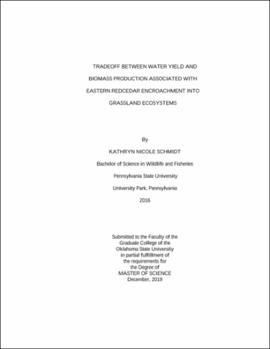| dc.description.abstract | Eastern redcedar (Juniperus virginiana) is encroaching tallgrass prairie ecosystems in the southern Great Plains disrupting multiple ecosystem services provided by these ecosystems. While not suitable for row crop production, these lands could be restored to native prairie or planted with switchgrass (Panicum virgatum) for use as a biofuel feedstock. While removal of redcedar tends to increase runoff, the tradeoff is unknown between ecosystem productivity and water use among redcedar, oak stands, switchgrass, and native prairie ecosystems. My objective was to determine the water use efficiency (WUE), i.e., productivity/water use of redcedar woodland, Cross Timbers oak woodland, switchgrass and native tallgrass prairie ecosystems. Data were collected in northcentral Oklahoma on nine experimental watersheds, four of which were initially redcedar, three of which were oak, and two of which were native prairie. Redcedar was cut from two watersheds and removed. One watershed was allowed to reestablish as native prairie and the other was planted with switchgrass. Tree aboveground biomass was determined using annually measured diameters and calculated using allometric equations. Herbaceous biomass was determined with annual clip plots. Aboveground net primary production (ANPP) was the difference in tree biomass between successive years plus annual herbaceous biomass. Runoff was continuously measured on each watershed using H-flumes. Annual evapotranspiration (ET) was estimated as the difference between precipitation and runoff. Annual WUE was calculated as the ratio between ANPP and annual ET. In 2018, ANPP of the switchgrass growing on cut redcedar watershed was 10.1 Mg ha-1 which was greater than for the other watersheds (4.6 to 7.1 Mg ha-1). Runoff was greater from the switchgrass watersheds (56.7 mm) and least from the redcedar (4.3 mm) and oak (2.7 mm) watersheds. WUE(s) of switchgrass watersheds (11.0 kg ha-1 mm-1) were greater than those of native prairie (7.2 kg ha-1 mm-1), oak (5.9 kg ha-1 mm-1) and redcedar (6.6 kg ha-1 mm-1) watersheds. Redcedar watersheds had higher ET, lower runoff and lower ANPP than switchgrass watersheds indicating that productivity, water yield and WUE can be increased by restoring encroached watersheds to native grassland or switchgrass systems. | |
